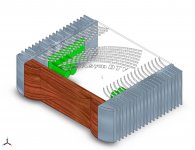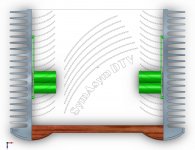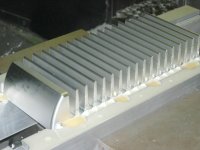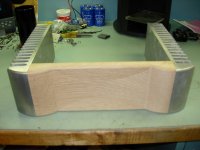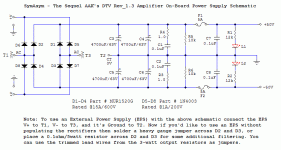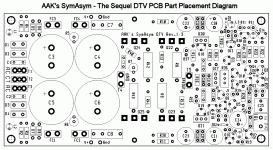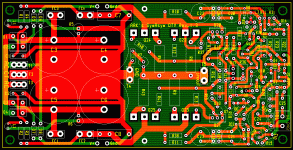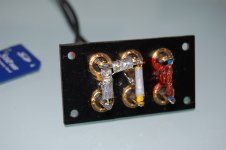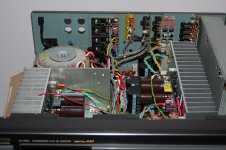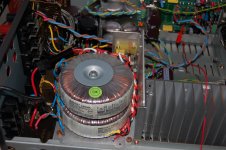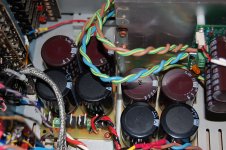Hello all, Nice to see folks moving along with this amp. I thought I would share my chassis progress.
The first 2 pics are my concept, some changes might be made yet.
The last 2 are what I have actually completed.
Heatsink is machined from billet, size is 2." x 4.75" x 12". The front panel is is oak. I am not sure of what finishes to use. Maybe polish all aluminum and oil on wood?
Transformers are on the way to me.
I hope to order parts in the next couple weeks. It"s just way to cold in my garage right now to do anything.
jim
The first 2 pics are my concept, some changes might be made yet.
The last 2 are what I have actually completed.
Heatsink is machined from billet, size is 2." x 4.75" x 12". The front panel is is oak. I am not sure of what finishes to use. Maybe polish all aluminum and oil on wood?
Transformers are on the way to me.
I hope to order parts in the next couple weeks. It"s just way to cold in my garage right now to do anything.
jim
Attachments
Hi Jim,
Boy that looks great. Where did you get the heat sinks? The oak front looks really nice. I also love working with wood.
Regards,
Al
Boy that looks great. Where did you get the heat sinks? The oak front looks really nice. I also love working with wood.
Regards,
Al
Hello all, Nice to see folks moving along with this amp. I thought I would share my chassis progress.
The first 2 pics are my concept, some changes might be made yet.
The last 2 are what I have actually completed.
Heatsink is machined from billet, size is 2." x 4.75" x 12". The front panel is is oak. I am not sure of what finishes to use. Maybe polish all aluminum and oil on wood?
I think aluminum has to anodized to better dissipate.
Did you cut metal and wood pieces yourself?
My parts have arrived today.
Time for the worst job- drilling and tapping the $$% heatsink!!
do you think a heatsink that is 8" wide by 5" tall with fin depth 2" is ok for 1 channel?
It better be cause that's what I'm using!
Time for the worst job- drilling and tapping the $$% heatsink!!
do you think a heatsink that is 8" wide by 5" tall with fin depth 2" is ok for 1 channel?
It better be cause that's what I'm using!
Hi Igreen,
Your heatsink should be fine. If it heats up too much drop the voltage across output transistors Q22/Q23 from the recommended 55mv to about 30mv.
Regards,
Al
Your heatsink should be fine. If it heats up too much drop the voltage across output transistors Q22/Q23 from the recommended 55mv to about 30mv.
Regards,
Al
Jim,
The facets in the oak are REAL slick!
 😉
😉
The contiuous curve into the heatsink should be easy to live with...
The facets in the oak are REAL slick!

 😉
😉The contiuous curve into the heatsink should be easy to live with...
Al & Ed, Thanks for the comments.
Carlmart, I might anodize after polishing. I cut these parts from solid stock on CNC machining center.
lgreen, why the $$% heatsink? it seems that you don't like doing this😱
jim
Carlmart, I might anodize after polishing. I cut these parts from solid stock on CNC machining center.
lgreen, why the $$% heatsink? it seems that you don't like doing this😱
jim
Jim,
You did an awesome job with your heatsinks, nice curves Show us the final apperance of you amp when you're done. I'm curious, I'm sure it would look beautiful! Are you a machinist?
Show us the final apperance of you amp when you're done. I'm curious, I'm sure it would look beautiful! Are you a machinist?
Fred
You did an awesome job with your heatsinks, nice curves
 Show us the final apperance of you amp when you're done. I'm curious, I'm sure it would look beautiful! Are you a machinist?
Show us the final apperance of you amp when you're done. I'm curious, I'm sure it would look beautiful! Are you a machinist? Fred
fred, thanks for the encouraging words. yes, i am a machinist, 30 plus years= old fart 😱
during winter, when i can't really build electronics i try to design and build chassis parts.
jim
during winter, when i can't really build electronics i try to design and build chassis parts.
jim
Al & Ed, Thanks for the comments.
lgreen, why the $$% heatsink? it seems that you don't like doing this😱
jim
Yes Jim you are very perceptive! I go carefully and slowly but still break a lot of taps in the hole and then I break the tap removal tools.
Yes Jim you are very perceptive! I go carefully and slowly but still break a lot of taps in the hole and then I break the tap removal tools.
i don't know how much perception that took😉
pm me and maybe together we can make tapping not so frustrating for you.
i don't want to stray too far ot in AAK's thread
jim
Hi All,
Attached is the latest Assembly Instructions document. I cleaned it up a bit adding some additional details where needed. I also added three transistor matching circuit diagrams for matching the input Jfets and output Bjts.
Since I couldn't include the Amplifier Schematic, PS Schematic, and Parts Placement Diagram in the document because of file size constraints I've attached them to this post.
Regards,
Al
Attached is the latest Assembly Instructions document. I cleaned it up a bit adding some additional details where needed. I also added three transistor matching circuit diagrams for matching the input Jfets and output Bjts.
Since I couldn't include the Amplifier Schematic, PS Schematic, and Parts Placement Diagram in the document because of file size constraints I've attached them to this post.
Regards,
Al
Attachments
is it possible to post a PCB layout on both sides? I have printed off the PCB pics, but they are not clear enough for my purpose.
Can you update the component layout to show Q1 & Q2 correctly oriented?
Can you update the component layout to show Q1 & Q2 correctly oriented?
Last edited:
the PCBs are delivered.
The assembly instructions MUST remind the builders that these two FETs should be assembled the right way around.
The k170 are reputed to be symmetrical, i.e. Drain and Source can be swapped and the device operates identically. If this really is the case then inserting them back to front should make no difference to performance. Can you guarantee that?
The assembly instructions MUST remind the builders that these two FETs should be assembled the right way around.
The k170 are reputed to be symmetrical, i.e. Drain and Source can be swapped and the device operates identically. If this really is the case then inserting them back to front should make no difference to performance. Can you guarantee that?
Andrew,
Step 6 of the Assembly Instructions section of the latest Assembly Instructions document clearly states in bold font the correct orientation for the 2SK170s.
I cannot guarantee they're symmetrical. Worth trying.
Al
Step 6 of the Assembly Instructions section of the latest Assembly Instructions document clearly states in bold font the correct orientation for the 2SK170s.
I cannot guarantee they're symmetrical. Worth trying.
Al
Last edited:
Hi Stanley,
Whatever you do the amp should be dead quiet (no AC hum) with the inputs shorted to ground. In my set up it's dead quiet with the inputs floating.
Regards,
Al
Hi Al,
My amp is also dead quiet without the RCA cables(input floating). The input FETs are quite sensitive and they will pick up hums if I use less-than-perfect RCA cables.
I had to make some modifications (shielding the mix resistors) to my $2 stereo-to-mono converter so that it does not pick up hums.
I have done only basic matching of the SST pairs & JFETs, offsets on both channels are less than 2mV.
I have installed the SymAsym PCBs inside a recycled AV amp case. The case is reasonably roomy - 6"(H) x 16"(D) x 17"(W) and I used the original heatsinks & the binding posts for outputs.
I made two external power supply boards, each with 4x 8200uF and 8x MUR1520 diodes. I did not leave enough space between the MUR1520s and they can get hot (80C) under extreme loads (200W into 4 ohms).
I installed extra aluminum plates to the small heatsink & they also serves as extra shielding for the transformers.
I am listening to the SymAsym and it sounds good & detailed.
Thanks for good works.
Cheers, Stanley
Attachments
Hi Stanley,
That's great, congratulations on a fine job. Be careful with the rectifiers with such loads using test signals as a source, it's an extreme test.
You'll need to break in the amps a bit before they settle in.
Really happy to see all working. 🙂
Al
That's great, congratulations on a fine job. Be careful with the rectifiers with such loads using test signals as a source, it's an extreme test.
You'll need to break in the amps a bit before they settle in.
Really happy to see all working. 🙂
Al
Last edited:
- Status
- Not open for further replies.
- Home
- Amplifiers
- Solid State
- SymAsym - "The Sequel", AAK's PCB Builders Thread
